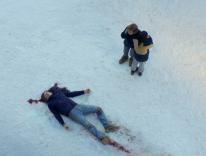Though The 300 was adapted from a Frank Miller graphic novel rather than from the histories of Herodotus or Plutarch, the Miller version (which I haven’t read) seems to include all the events of the heroic stand at Thermopylae in 480 bc that you would want to see on a movie screen. Here we have King Leonidas of Sparta and his elite troops facing the massive army of Xerxes at that narrow pass in northern Greece and heroically holding the Persians back long enough for the Greek allies in the south to get organized. And the time-honored inspirational meaning of the sacrifice has been maintained. As H. D. F. Kitto put it, the “Asiatic master compelled obedience by torture and the lash; the Greeks took their decisions by debating and persuading and then acted like one man; and they conquered.” So for those who believe that the worth of a movie is determined strictly by its events, and that the quality of its dialogue, acting, visuals, and tempo are all just so much window dressing, The 300 will be a rewarding experience. But for people like me who believe that dialogue, acting, visuals, and tempo constitute the real achievement of drama and film, that a scenario is only the intent, and that the intent must never be mistaken for the deed, The 300 is a pretty crummy movie.
As the historian Victor Davis Hanson points out in his introduction to a “booktrailer” (AKA advance advertising) published by Dark Horse Comics, “the film was not shot on location outdoors, but in a studio using the so-called digital backlot technique of sometimes placing the actors against blue screen.” (This screen allows the settings and even certain characters to be created digitally.) “The resulting realism is not that of the sun-soaked cliffs above the blue Aegean-Thermopylae remains spectacularly beautiful today-but of the eerie etchings of the comic book.” The historian means this as artistic apologia but with friends like Hanson, what movie needs detractors? Yes, the film has a perpetually overcast, bronze-tinted, clammy look, as if Greece were one big bog. If this is being true to the graphic novel’s “eerie etchings,” then the movie’s director, Zack Snyder, should have dared to be false. Were not the Greeks in general and the Spartans in particular fighting, in a sense, for sun-soaked earth and azure water? To be sure, they were battling above all for their liberty, but wasn’t Greek patriotism imbued with the beauty of their homeland? That The 300 isn’t realistic doesn’t bother me in the least, but that it shows not a scintilla of concern to give us insight into a world at once so alien and so important to us arouses my contempt.
Consider the special effects: a wolf with eyes like light bulbs; a gigantic ogre straight out of The Lord of the Rings; a Xerxes who is also a giant, though an effeminate one; a treacherous shepherd more humpbacked than Quasimodo and twice as repulsive as Gollum. I grant that history can be fruitfully recast as legend or fantasy (American movies constantly do this with Abraham Lincoln), but the visual style of this movie’s fantasy isn’t redolent of Homer or even of Beowulf but of Beowulf’s degenerate offspring, Conan the Barbarian. Thermopylae deserves better than Conan.
The acting and the dialogue follow suit. Everyone in the cast either bellows or hisses. And consider what they are bellowing and hissing. One young warrior to another after a battle: “You still here?” Second young warrior: “Somebody’s gotta watch your back.” Holy hoplite, Batman! Or this Oprahism from a bereaved father: “It’s not that my son’s been killed, but that I never got to tell him that I loved him.”
The combat scenes are staged not for maximum cinematic excitement (remember the superb gladiatorial dueling of Kirk Douglas and Woody Strode in Spartacus?) but to look like the monotonous, clunky, herky-jerky fights in video games. Of course moviegoers, unlike game players, don’t get to participate, so the computerized look never truly grips. As for that visual cliché-a warrior leaps forward to deliver a blow, gets freeze-framed midair (so that we can savor what exactly?), then resumes combat at normal tempo-wasn’t this visual gambit satirized to death by Shrek?
Yet here’s the worst thing about The 300: It has no real sense of heroism. True, the historical Spartans-exposers of underweight babies and predators of their neighbors-are hard for us to take no matter how they’re presented, but they were, after all, courageous and devoted to their version of democracy. Here they come across, at best, as frat-house bullies and blowhards and, at worst, as sadists and psychopaths. In fact, the movie never gets beyond the muscle-worship of a male twelve-year-old: hence the identical digitalized pectoral muscles on all the Spartan soldiers, while a quisling politician gets a normal chest and unswollen biceps; hence the treachery of the shepherd Ephialtes is presented as a function of his deformity. Consider too that the Spartan narrator sneers at some neighboring citizen-soldiers fighting beside Leonidas’s troops because, between wars, they pursue such unheroic, sissy occupations as farming, pottery, and sculpture. He dismisses them as “brave amateurs” who “make a mess of things.” But where in the movie do we see them making a mess of things? True, they back out of the final fight because they consider it suicidal folly, but until then they seem to have fought with competence. And wasn’t the war finally won by the citizen soldiers of all Greece? Weren’t the Spartans themselves citizen-soldiers and not at all what we think of as professional soldiers?
One of our wiser generals recently used the term “chicken hawks” to describe those politicians and political commentators fired up to send our troops into combat without any personal sense of the hell that combat can be. I think The 300 was made for such chicken hawks.
Please email comments to [email protected] and join the conversation on our Facebook page.
Share
Previous Story
An Unfinished Agenda
Next Story
The Sobrino File


